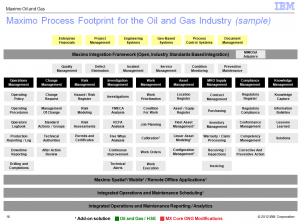THE MAXIMO/TRIRIGA MANAGER’S BLOG
Maximo for Oil and Gas
Those who do not invest in the economic opportunities offered by each technological revolution will be left behind.
Carlotta Perez, Technological Revolutions and Financial Capital
When people look at Mars or other planets, their first thought is to know if they have water, and if there might be life. But here on earth where water is abundant and life as we know is populating more by the hour, except possibly in Europe, we tend as ask ourselves not questions about water but how much oil and gas is left, for oil and gas surely are the most important commodities supporting our modern, comfortable lifestyles.
Because of its importance to our well being, The Maximo Manager’s blog will write three articles on Oil and gas. The next article will focus on how IBM Tririga helps large oil and gas companies manage capital projects, and the third will focus on the importance of standards such as Petroleum Institute Data eXchange and API standards like 580/581 as examples of why standards are important.
Oil and gas provides us with an easier life, but those who have read Daniel Yergin’s “The Prize” or “The Quest” or John Browne’s “Beyond Vision” are aware that an oil and gas operation is probably the least easy business to manage, not only publicly but privately as well.
Whether a business is easy or difficult to run, a manager’s responsibility is to make resources productive, and these production objectives must be aligned to labor and capital, and most assuredly driven by sophisticated software.
When I first worked with Maximo in 1997, it was at ADCO (Abu Dhabi On-Shore Oil Company), and at that time we did not have a contracts module. Russell Bee was the Maximo project manager and lead engineer at ADCO, and he and other PSDI personnel working at ADCO and ADNOC put together the contracts module for oil and gas that ultimately became the standard Maximo contracts application.
Russell Bee, a former aircraft engineer, is still working with Maximo and under his Oil and Gas leadership it continues to soar. Since that early period of Maximo at the oil companies, major improvements have been made that provide oil and gas operations with the type of software required to drive productivity and also with the type of sophisticated technology cited by Carlotta Perez in her seminal work, “Technological Resolutions and Financial Capital.”
If we think of productivity as being how resources are utilized and what their yield is, then the many new features of Maximo Oil and Gas’s provides industry specific solutions that are helping drive manageable and measurable results across the various departments.
From a manager’s perspective, what value does a product like Maximo for Oil and Gas bring to operations and how does it help a manager align his activities with short- and long-term objectives.
If a picture is worth the proverbial 1,000 words, then:
Welcome to the new world of Maximo asset and operations management, where managers work in a collaborative environment that links their work across all departments and aligns their activities with organizational goals. Using Maximo, project management is budgeted and aligned with financial goals. Engineering, Geo-based and process control systems collaboratively connect and all documents, across all departments, are stored in Maximo or in the organization’s Document Management system such as Filenet, Sharepoint, or Documentum.
Each employee knows that his contribution to productivity is aligned with organizational goals, and each manager has feedback and a portal view across all their departments.
If productivity is a balance between many factors, which occur across many departments, then Maximo’s operational alignment provides management with the tools needed to plan, execute and measure that objectives are being delivered, that rules and regulations are being complied with.
However, the Oil and Gas industry must not only be productive in a very competitive market, but they are under close scrutiny to meet regulatory compliance and adhere to health, safety and environmental standards.
As an example of these HSE standards, let’s compare BP’s recent problem in the gulf to bridge failures in the United States. According to a report some year back from National Traffic Highway Traffic Safety Administration, half of the nation’s 565,000 bridges are unsafe. Bridges collapse, dams burst, but according to Sam Florman in his well respected book, “The Civilized Engineer,” the papers are filled for a week or two with outrage, politicians call for legislation, but ultimately very little is done. His conclusion: when it costs the taxpayer very little is done but when it does not cost the taxpayer and instead it costs a company then new, very strong legislation and penalties are called for.
Maximo for Oil and Gas provides additional software features such as Management of Change, Regulatory Compliance, Incident Management, Investigations, Field Tickets and control of Health, Safety, & Environment risks, so that environmental accidents that occurred in the past will be greatly reduced in the future, thus creating a safer and cleaner environment, or as safe and as clean as possible when serving the needs and desires of a billion families and their economic lifestyles.
When my son and I are standing on a mountain top and he asks me, “Daddy, is it true there is water and people on Mars?”, I reply that I do not know, but I do know that I am very happy there is oil and gas here on earth and that IBM Maximo and its oil and gas customers are making it possible to continue leading our family’s comfortable lifestyle.
Author: Richard Taggs




